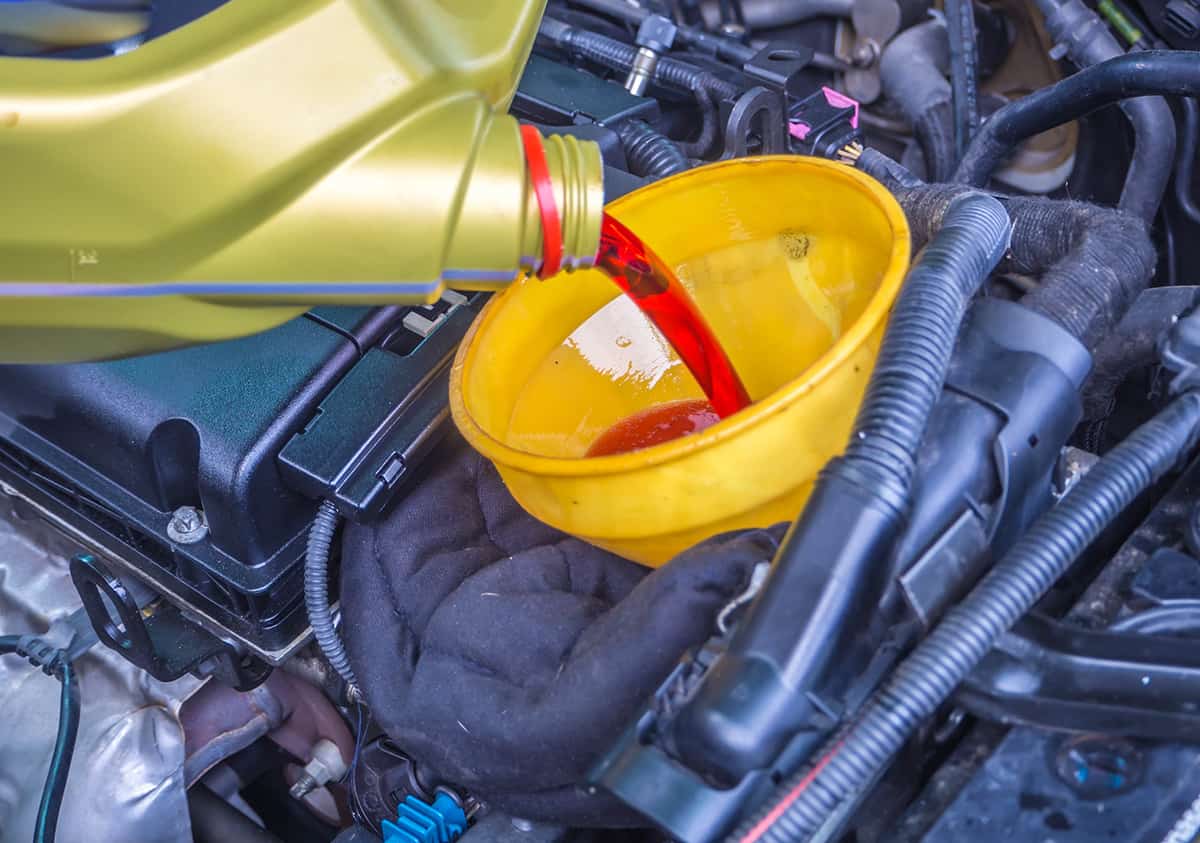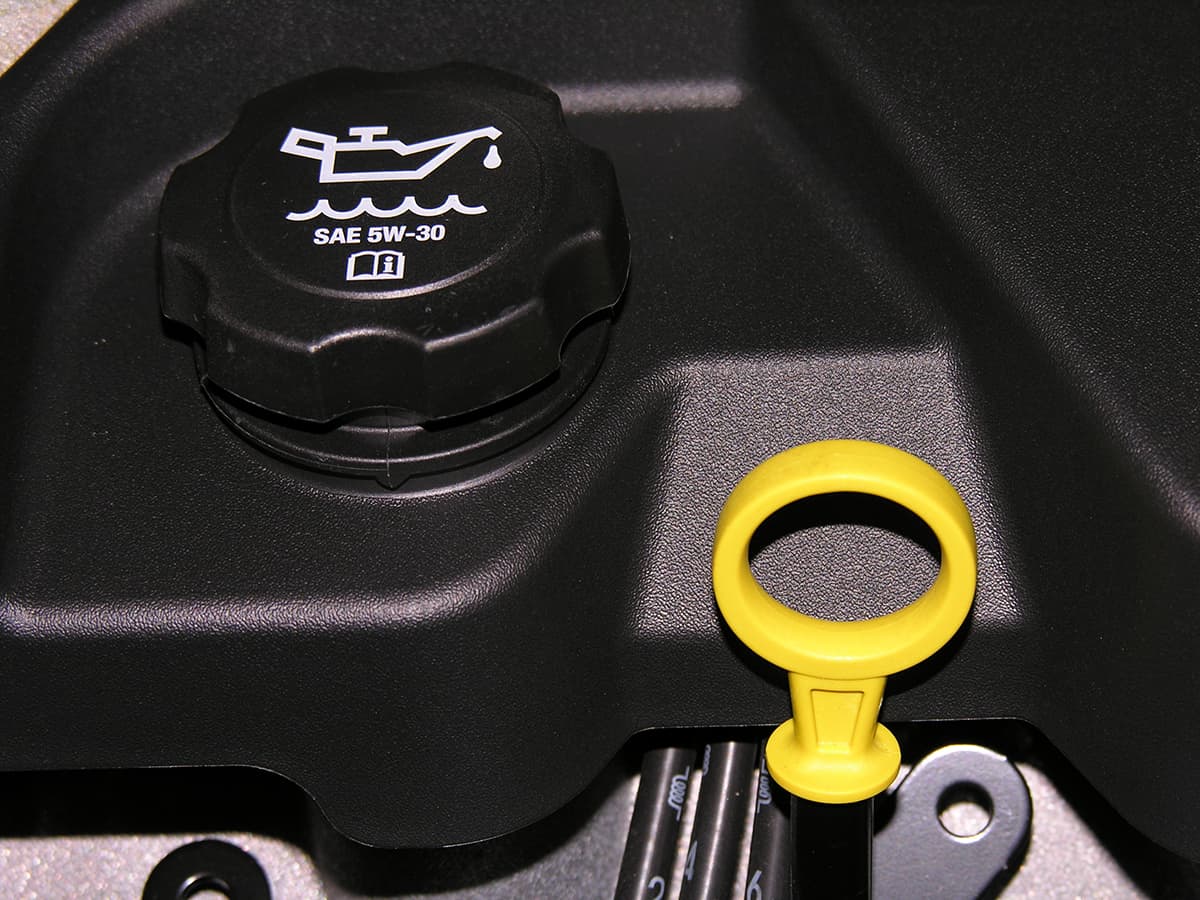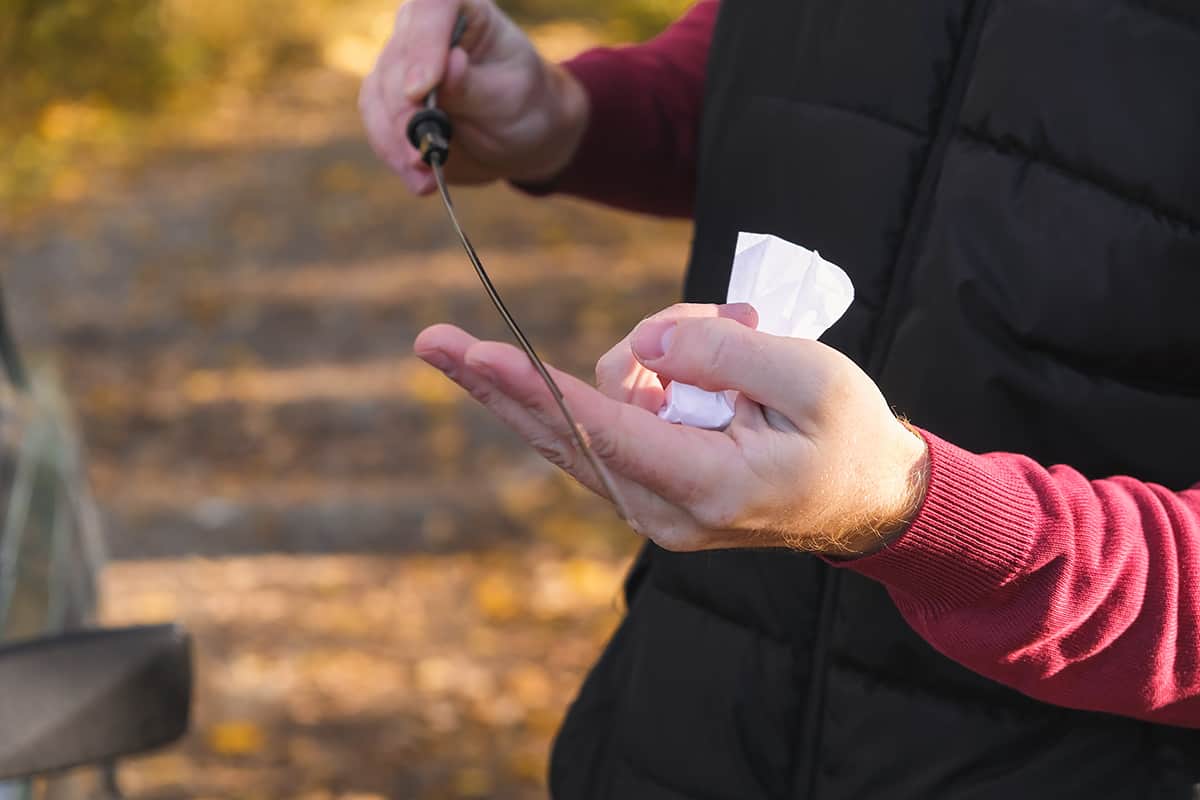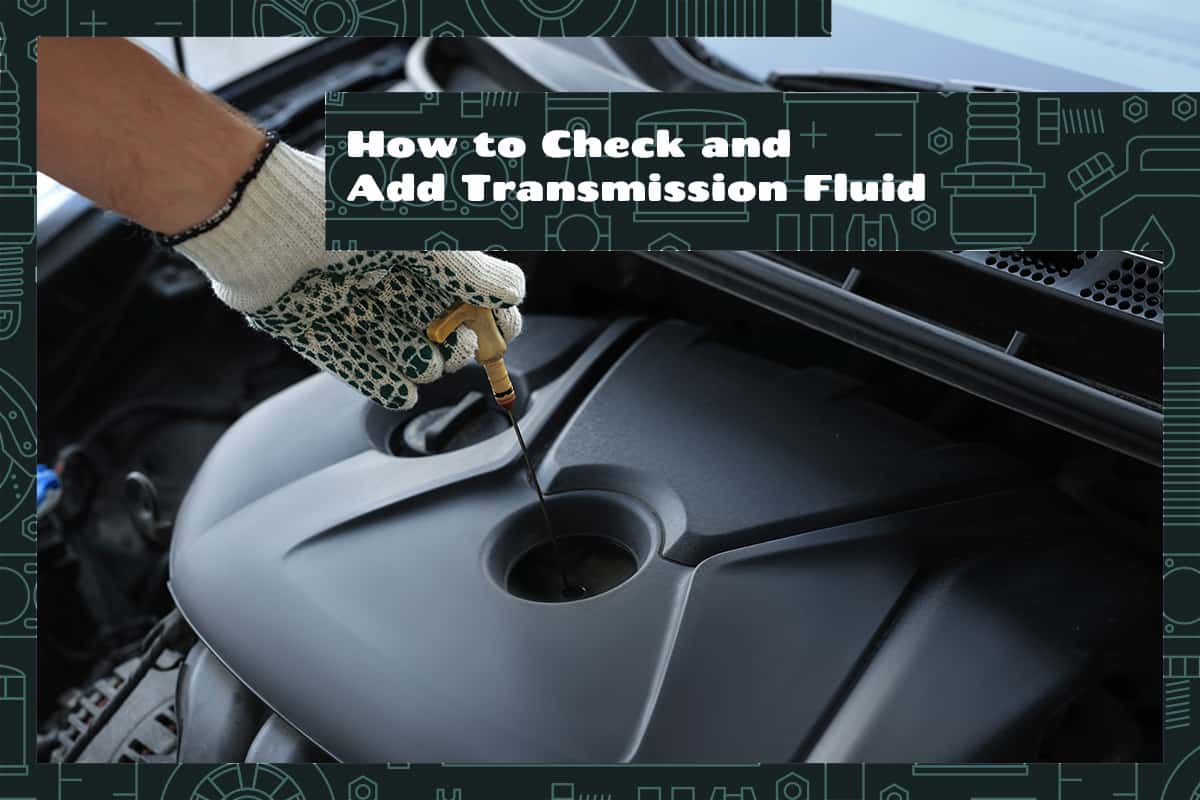In our cars, there’s a special fluid called ‘transmission fluid’ that helps keep everything running smoothly, sort of like the oil in a bicycle chain. Without it, gears can get sticky, and your car won’t shift properly, which can lead to serious damage. So, checking and adding this fluid is really important.
So, how do we check and add transmission fluid?
- Park your car on a level surface
- Start the engine and let it warm up
- Locate the transmission fluid dipstick
- Pull it out, wipe it clean, and insert it back
- Pull it out again to read the fluid level
In this article, we’ll go step-by-step through this process, making sure you know how to properly check and add transmission fluid to your car. You’ll learn when and why it’s important and how to do it safely and effectively.
Where Is Transmission Fluid?
When you pop open the hood of your car, you’re met with a complicated-looking mix of parts and components. One crucial part in there is your transmission, a piece of machinery that ensures your engine’s power gets to your wheels properly.
The transmission fluid is stored in the transmission of your car. Whether you have an automatic or manual transmission, this component is typically found bolted to the vehicle’s engine, towards the center and back of the engine compartment.
When your car is running, the transmission fluid travels from the transmission pan, up through the transmission’s inner workings. It lubricates gears and parts, prevents overheating, and helps facilitate gear shifts. The fluid’s journey is continuous, and it’s this constant circulation that keeps your car running smoothly.
When Should You Add Transmission Fluid?

It can’t be understated how important it is to make sure your car has enough transmission fluid at all times. But how do you know when it’s time to add more? In this section, we will dive into the signals and situations that might call for additional transmission fluid.
1. Checking the Fluid Level
It all starts with a simple check. Your car’s transmission fluid level can be measured using the dipstick. If the level is below the ‘Full’ mark and closer to the ‘Add’ or ‘Low’ mark, that’s your cue. It indicates your car could use more transmission fluid. Regular checks, as guided by your vehicle’s manual, are the first step in ensuring your transmission fluid is always at the right level.
2. Strange Sounds and Smells
If your car starts to make unusual noises while you’re driving, it might be trying to tell you something. One potential cause could be low transmission fluid. This can lead to metal parts grinding together, creating an unusual sound. Furthermore, if you notice a strange smell coming from your car, like something burning, it could be due to overheated transmission fluid, again indicating a potential need to add more fluid.
3. Shifting Issues
The transmission fluid plays a vital role in helping your car shift gears smoothly. If your car is struggling to shift gears, or if the shifts are unusually hard or delayed, this could mean that your transmission fluid level is low. It’s your car’s way of telling you that it might be time to add more fluid.
4. Fluid Color and Condition
Fresh transmission fluid is generally clear or pink in color and has a slightly sweet smell. If you notice that the fluid has turned dark or has a burnt smell, it’s usually a sign of aged or contaminated fluid that needs to be replaced. In this situation, you might need to not only add fresh fluid but also replace the old fluid entirely.
5. Transmission Overheating
The transmission fluid helps to keep your transmission cool. If your car’s temperature gauge shows a higher reading than usual or if there’s smoke coming from under your car’s hood, it might be because your transmission is overheating. One reason for this could be low transmission fluid. If this happens, adding fluid may be necessary after the car has cooled down.
Steps by Steps Guide to Check and Add Transmission Fluid?
As a car owner, you should know how to check and add transmission fluid to your car. Regularly performing this straightforward task can help your car run smoothly and prevent expensive damage to your transmission. Let’s break it down into simple steps that you can easily follow.
Step 1: Preparation
Before we start, make sure your car is parked on a flat, level surface. You also need to allow your car’s engine is warm because transmission fluid expands when it’s hot. These steps are to ensure that the fluid level reading is accurate.
Step 2: Locate the Dipstick

Open your car’s hood and find the transmission fluid dipstick. This dipstick is typically marked and often has a red or brightly colored handle. In an automatic transmission, it’s usually located toward the back of the engine compartment.
Step 3: Check the Fluid Level
Pull the dipstick out of the tube, wipe it clean with a cloth or towel, then reinsert it back into the tube. Pull it out again and look at the end of the dipstick. You’ll see markings for ‘Low’ and ‘Full’. The fluid should be somewhere between these two markings.
Step 4: Check the Fluid Condition

While you’re checking the level, also pay attention to the fluid’s color and smell. Good transmission fluid should be clear or slightly red and have a mild smell. If it’s dark or smells burnt, it might be time for a fluid change.
Step 5: Add Fluid if Necessary
If the fluid level is below the ‘Full’ mark and closer to ‘Add’ or ‘Low’, you should add more transmission fluid. Use a funnel to add the fluid through the same tube that houses the dipstick. Be sure to use the type of transmission fluid specified in your car’s manual. Add a little at a time, checking the level repeatedly to ensure you don’t overfill it.
Step 6: Recheck the Fluid Level
After adding the fluid, reinsert the dipstick, then remove it to recheck the fluid level. If it’s between ‘Low’ and ‘Full’, you’re good to go. If it’s still low, repeat Step 5. If it’s above ‘Full’, you’ll need to drain some.
Step 7: Replace the Dipstick
Once the fluid level is correct, make sure to replace the dipstick securely. Close the hood, and your job is done.
Things to Know When Checking and Adding Transmission Fluid
Before adding transmission fluid to your car, there are a few things you should know beforehand. Let’s go through these key points to ensure that you’re handling this task correctly and safely.
1. The Importance of Regular Checks
Firstly, you should perform regular checks on your transmission to ensure its well-being. Regular checks can help spot any potential issues early on before they become significant problems.
Here are several things you should keep an eye on during your checks:
- Fluid Level: The transmission fluid level is one of the most crucial aspects to check. If the fluid level is too low, it may not provide adequate lubrication and cooling for your transmission, leading to potential damage. If it’s too high, it can cause other issues, such as foaming and erratic shifting.
- Fluid Condition: Besides the level, the condition of your transmission fluid is also vital. Healthy transmission fluid should be clear or slightly red and have a mild smell. If the fluid is dark, cloudy, or has a burnt smell, this could indicate a problem that requires attention.
- Leaks: During your regular checks, you should also look for signs of leaks. This could be a spot of fluid under your car after it has been parked for a while or a lower-than-normal fluid level on repeated checks. A leak should be addressed promptly to prevent further damage.
- Transmission Behavior: While not a direct part of checking the transmission fluid, being aware of how your transmission behaves can provide valuable clues to potential problems. If you notice things like slipping gears before heating up, hesitation, or odd noises when shifting, this might indicate an issue with your transmission fluid or the transmission itself.
- Service Intervals: Make sure you’re aware of your vehicle manufacturer’s recommended service intervals. Regular maintenance, including transmission fluid changes, plays a key role in your vehicle’s longevity and performance.
2. Not All Cars Have Dipsticks
While most cars with automatic transmissions have dipsticks for checking the transmission fluid, some newer models do not. Some cars, particularly those with manual transmissions, may require professional servicing to check and replace transmission fluid. Always check your vehicle’s manual to understand what applies to your car.
3. Fluid Condition Matters
When you check the transmission fluid, pay attention not only to the level but also to its condition. If the fluid is dark or smells burnt, it may be time for a change. Keeping fresh, clean transmission fluid in your car is crucial for its overall health and performance.
4. Using the Right Fluid
Not all transmission fluids are the same. Different cars may require different types of transmission fluid, so it’s essential to know which kind your vehicle needs. Always check your car’s manual or consult with a professional to make sure you’re using the correct type of fluid.
Here’s a brief summary of different transmission fluid types based on this guide:
- Dexron/Mercon: These are the most common types of transmission fluid used in vehicles with automatic transmissions. Many car manufacturers use either Dexron, Mercon, or a fluid that meets Dexron or Mercon specifications. These fluids have been developed over the years, and there are now multiple versions with different specifications.
- Type F: This transmission fluid type was originally designed for Ford vehicles, hence the name “Type F”. While it’s not as commonly used today, some older Ford vehicles may still require it.
- Hypoid Gear Oil: This type of fluid is typically used in manual transmissions. It’s thicker than the fluid used in automatic transmissions and has different characteristics to deal with the different demands of manual transmission operation.
- Continuously Variable Transmission (CVT) Fluid: CVT transmissions are becoming more common in modern vehicles. They require a specific type of transmission fluid that is different from Dexron/Mercon fluids.
- Synthetic Fluid: Synthetic transmission fluid is designed to offer better performance over a wider range of temperatures and to last longer than conventional transmission fluid. Some high-performance or high-mileage vehicles may require or benefit from a synthetic fluid.
5. How to Add Fluid Properly
If you find that you need to add transmission fluid, it’s important to do it correctly. Use a clean, long-neck funnel to add the fluid to the dipstick tube. Add a bit at a time, continually checking the level to ensure you don’t overfill it. And remember, after adding fluid, you should always check the level again with the engine running and the transmission in ‘Park’ mode (for automatic transmissions).
6. Beware of Overfilling
Overfilling the transmission fluid can be just as harmful as having too little. It can lead to frothy fluid, which can cause erratic shifting, loss of internal lubrication, and potential damage. So, take care to add fluid gradually and check the level frequently.
Oddly enough, the signs of using too much transmission fluid are similar to when your car has too little of it. If you added fresh fluid to your transmission, keep an eye out for these signs:
- Difficulty Shifting Gears: Overfilled transmission fluid can create extra pressure and frothing, which messes with your car’s ability to shift gears smoothly.
- Unusual Sounds: The frothing cause your car to make gurgling or whining sounds, especially when you’re trying to change gears.
- Leaking Fluid: The transmission fluid has nowhere to go but outside the transmission system. You might see this as a puddle under your car, which can be red or brown.
- Overheating: This happens because the extra fluid can cause the transmission to work harder than it should. If your car’s temperature gauge starts creeping up, it might be a sign that your transmission fluid is overfilled.
- Transmission Damage: The worst-case scenario is that the extra transmission fluid can damage parts of your car. The extra strain the system exerts in order to pass the transmission fluid can lead to unnecessarily costly repairs.
7. Professional Help is Sometimes Needed
While checking and adding transmission fluid can be a DIY task, there may be situations where you need professional help. If you’re having trouble finding the dipstick, if your car doesn’t have one, or if you notice anything unusual about your transmission fluid or how your car is running, it may be time to consult a professional.
Transmission Fluid Change Cost
Maintaining your car includes regular transmission fluid changes, but how much does this usually cost? Several factors can influence the cost of a transmission fluid change, and this section will help you understand these costs so you can plan effectively and ensure your vehicle continues to run smoothly.
1. The Average Cost
Generally, you could be looking at anywhere between $100 to $300 for this service. For a more accurate estimate, you should get a personalized quote tailored to your specific vehicle and circumstances.
2. Transmission Fluid Cost
The type of transmission fluid your vehicle requires is one factor that affects the total cost. Certain vehicles may need specific types of transmission fluid, and these can vary in price. Typically, a quart of transmission fluid might cost anywhere from $5 to $20.
3. Labor Cost
When considering the costs of a transmission fluid change, labor is a significant component. The procedure includes draining the old fluid, which may involve removing the transmission pan, replacing the filter if necessary, and finally adding the new fluid. These tasks can be quite labor-intensive and time-consuming.
4. Location
Where you get your transmission fluid changed can also affect the price. Dealerships and franchise shops can sometimes charge more than independent mechanics or quick-lube spots. However, prices can also vary significantly between different regions due to differences in local economies and operating costs.
5. The Frequency of Changes
The frequency of transmission fluid changes can also impact the overall cost. Many car manufacturers recommend changing the transmission fluid every 30,000 to 60,000 miles, but it’s important to check your vehicle’s manual for the manufacturer’s specific recommendations. More frequent changes might mean a higher ongoing cost, but they can also help prevent costly transmission damage in the long run.
6. Transmission Fluid Change vs. Flush
One more factor that will significantly affect the cost is the type of service being performed: a transmission fluid change or a transmission flush. A fluid change is less comprehensive, replacing about 40-50% of the fluid, essentially just replenishing the system.
On the other hand, a transmission flush is a more extensive procedure. It replaces 100% of the fluid and cleans out the system, removing any debris or contaminants that may have accumulated over time.
This process requires more work and more fluid, hence it usually costs more. You could be looking at up to around $250 for a flush, but it’s important to consult with your mechanic to see which service is most appropriate for your vehicle.
7. Additional Services
When having a transmission fluid change, your mechanic might suggest additional services to ensure your transmission runs optimally. One of these services could be replacing the transmission filter, a component that helps keep your transmission fluid free of debris and contaminants. This ensures only clean fluid circulates within your transmission.
Another common extra service is the replacement of the gasket, which seals the connection between the transmission pan and the rest of the transmission. This gasket is crucial to prevent fluid leaks. Both of these services, while adding to the upfront cost, contribute to the health and longevity of your transmission. They can prevent more costly repairs in the future, much like eating healthy can prevent expensive medical treatments.
Just make sure you know the basics of what the mechanic is offering—you don’t want to end up paying to get your wheels rotated if they don’t need it, after all!
FAQs
1. Do you check transmission fluid while the car is running?
Yes, you check the transmission fluid while the car is running. This is because the transmission fluid warms up and expands when the car is on, giving a more accurate reading. To do this, you would start your car and let it run for a few minutes to warm up the fluid. After this, you would park it on a level surface, keep it running, and then pull out the transmission fluid dipstick to check the level and color.
2. Can you add transmission fluid when the car is hot?
Yes, you can add transmission fluid when the car is hot, but be careful not to burn yourself. The engine and transmission components can be very hot after running. When adding fluid, ensure you don’t overfill it as too much fluid can cause issues just like having too little. It’s always good to add a little bit at a time and keep checking the level until it’s right.
3. Where does transmission fluid go?
Transmission fluid is stored in the transmission fluid pan, which is located at the bottom of the transmission. When the car is running, the fluid is pumped out of the pan, through the transmission, where it lubricates the moving parts, keeps everything cool, and helps transmit power from the engine to the wheels. When you add more fluid, it goes directly into the pan through a fill tube that is typically accessed under the hood.
4. What happens if you don’t change your transmission fluid?
Not changing transmission fluid can lead to an array of problems. Eventually, the fluid can break down and stop providing proper lubrication and cooling. It can also become contaminated with tiny metal particles from the transmission’s moving parts.
This can cause the transmission to run hotter, work less efficiently, and wear out sooner. In severe cases, not changing your transmission fluid could lead to costly transmission damage that requires repairs or replacement.
5. How often should you change transmission fluid?
How often you should change your transmission fluid can vary based on your vehicle, the type of transmission, and how you use your car. Generally, many manufacturers recommend changing the transmission fluid every 30,000 to 60,000 miles, with some cars needing a change after 100,000 miles.
But if you often drive in severe conditions, like heavy traffic, hot weather, or while towing a trailer, you might need to change the fluid more often. Check your vehicle’s manual for the manufacturer’s specific recommendation for your car.






